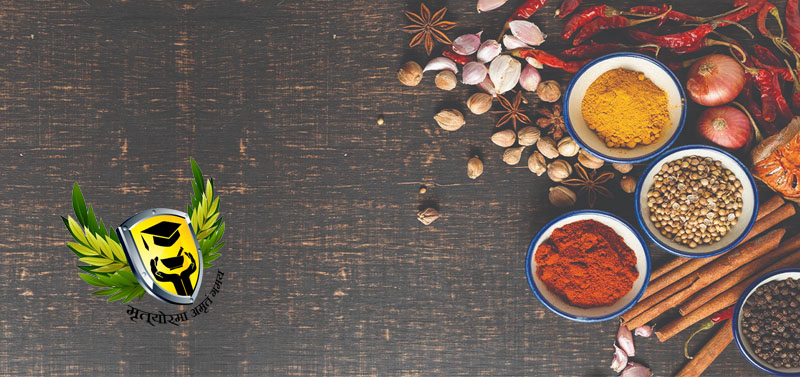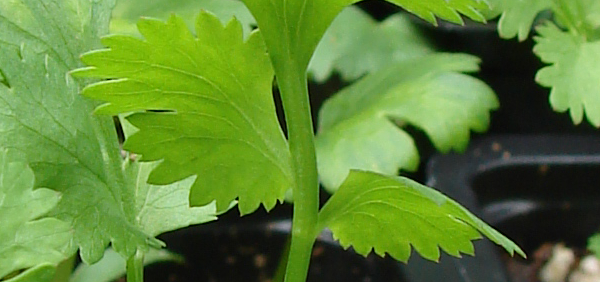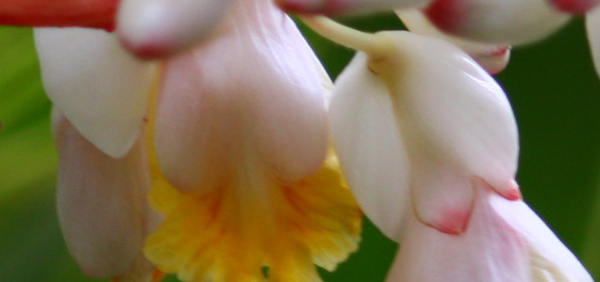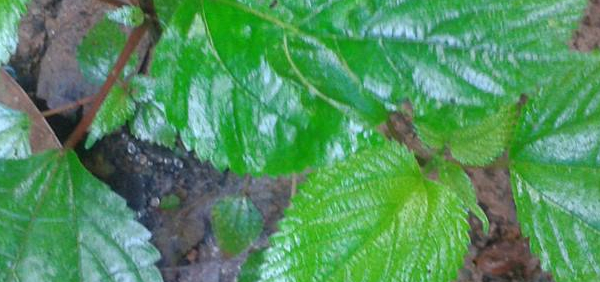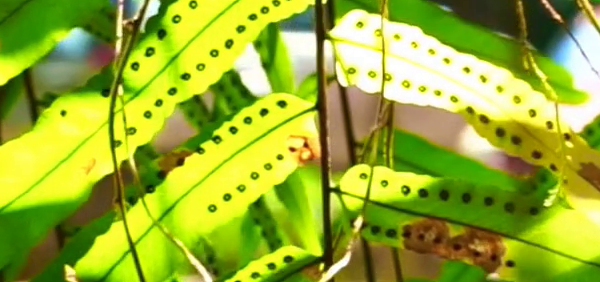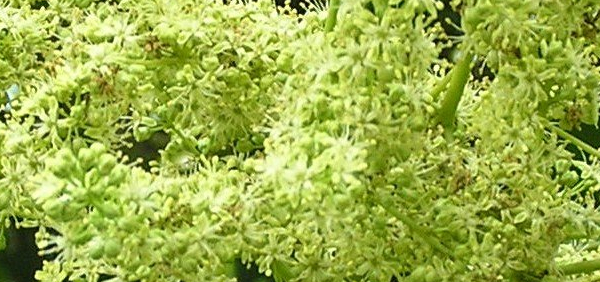kasamarda :
 Cassia occidentalis Linn, usually grows in the southern part of I ndia which is known as Kasmard in Sanskrit, Kasondi in Hindi and Coffee Senna in English. The plant belongs to Caesalpiniaceae family. The common name is Ponnavarai in Tamil. The roots, leaves and seeds are the parts of the plant used. It is an erect herb, commonly found by road sides, ditches and waste dumping sites. Cassia occidentalis has been widely used as tr aditional medicine. Entire parts of the plant hav e medicinal values
Cassia occidentalis Linn, usually grows in the southern part of I ndia which is known as Kasmard in Sanskrit, Kasondi in Hindi and Coffee Senna in English. The plant belongs to Caesalpiniaceae family. The common name is Ponnavarai in Tamil. The roots, leaves and seeds are the parts of the plant used. It is an erect herb, commonly found by road sides, ditches and waste dumping sites. Cassia occidentalis has been widely used as tr aditional medicine. Entire parts of the plant hav e medicinal valuesHISTORICAL AND MYTHOLOGICAL REVIEW:
Coffee senna is a plant that is naturalized in most parts of tropical South America and Amazon.It is also indigenous to Brazil and areas with warmer climates like south, north and Central America.
Coffee senna has a long history when it was used for various things. But specifically it is used as medicinal herb in many parts of world.
Taxonomical Classification
Kingdom: Plantae - Plants
Subkingdom: Tracheobionta - Vascular plants
Superdivision: Spermatophyta - Seed plants
Division: Magnoliophyta - Flowering plants
Class: Magnoliopsida - Dicotyledons
Order: Fabales
Family: Fabaceae
Genus: Cassia
Species: Cassia occidentalis
Allied species:
VERNACULAR NAMES
Sanskrit: Kasamarda, Vimarda, ArimardaEnglish: Negro coffee , Coffee Senna, coffeeweed
Hindi: Kasunda, Bari kasondi
Urdu: Kasonji
Telugu: Thangedu
Bengali: Kalkashunda
Marathi: ran-takda, kasivda, kasoda, rankasvinda
Oriya: Kasundri
Gujarathi: Kasundri
Tamil: Nattam takarai, Payaverai
Malayalam: Mattantakara
Kannada: Kolthogache
Punjabi: ਕੌਫੀ ਸਿੰਨੇ Kauphī sinē
Sindhi: ڪافي سينن
Arabic: سينا القهوة sina alqahua
Spanish: Bicho, Brusca, Frijolillo, Guanina.
Assamese: Hant-thenga
Japanese: Habuso
Chinese: Wang Jiang Nan, Wang jiang nan jue ming.
French: Bentamar, Bonne casse
German: Kaffeekassie.
Burma: Ka.sau.poap, Sham:ka.sau., Sham:ka.zau, Tan.kywè:kri:
Nepal: Kasaudi, Panvar
Persian: قهوه سنا
Sinhalese: Penitora
Greek: καφέ senna kafé senna
Varities:
classical categorization- Susrutha , Vagbhata - Sarasadi Gana
- aiyadeva nighantu - Oshadhi Varga
- Dhanvantiri nighantu - Karaveeradi varga , mishraka varga
- Bhavaprakasha Nighantu - Shaka varga
Definition
Synonyms
Synonyms in Ayurveda: kashamarda, rajavriksha, kasaghna, pitapushpaka, dipana, kanak, jaranakala, kartakasaghna, anjanRasa: Madhura Tikta
Guna: Laghu Ruksha
Veerya: Ushna
Vipaka: Katu
Karma: Krimighna
Coffee Senna seeds are attributed with blood purifying and diuretic properties. The herb has been traditionally used to normalize bowel movements. It is a related species of Senna, a much stronger purgative. The seeds are also beneficial in treating whooping cough, convulsions and heart disease. Despite its name, which comes from its occasional use as a coffee substitute, Coffee Senna is absolutely unrelated to coffee!
Cultivation:
Coffee senna has a wide native range from the subtropics of S. America through to southern N. America and the Caribbean. It grows mainly at lower elevations. It favours moister areas in the tropics, in Puerto Rico it grows in areas where the mean annual rainfall is within the range 1,000 - 2,200mm.Prefers a deep, well-drained, moderately fertile sandy loam and a position in full sun.
Originally native of the Americas, the plant is widely cultivated through the tropics and subtropics and is commonly naturalized in many areas. While coffee senna can be a weed of cultivated fields and plantations, it is principally a problem because it accumulates in heavily grazed pastures.
The plant flowers throughout the year in non-seasonal climates.
The plant has a disagreeable odour when crushed.
There are conflicting reports on whether or not this tree has a symbiotic relationship with certain soil bacteria, so it is unclear as to whether this tree fixes atmospheric nitrogen.
Propogation:
Like many species within the family Fabaceae, once they have been dried for storage the seeds of this species may benefit from scarification before sowing in order to speed up and improve germination. This can usually be done by pouring a small amount of nearly boiling water on the seeds (being careful not to cook them!) and then soaking them for 12 - 24 hours in warm water. By this time they should have imbibed moisture and swollen - if they have not, then carefully make a nick in the seedcoat (being careful not to damage the embryo) and soak for a further 12 hours before sowing[]. Some 95% of scarified seeds sown in potting mix germinated between 5 and 36 days after sowingHarvesting:
- Flowering: March, June
Phytochemistry:
The chief constituents in this herb are achrosine, aloe-emodin, anthraquinones, anthrones, apigenin, aurantiobtusin, campesterol, cassiollin, chryso-obtusin, chrysophanic acid, chrysarobin, chrysophanol, chrysoeriol, emodin, essential oils, funiculosin, galactopyranosyl, helminthosporin, islandicin, kaempferol, lignoceric acid, linoleic acid, linolenic acid, mannitol, mannopyranosyl, matteucinol, obtusifolin, obtusin, oleic acid, physcion, quercetin, rhamnosides, rhein, rubrofusarin, sitosterols, tannins, and xanthorin.
PHARMACOLOGY:
Few medicines containing Cassia occidentalis
- Himalaya Liv.52 for Liver care
- Himalaya Bonnisan
- Himalaya Herbolax Tab for Constipation
- Himalaya Geriforte
- Pancha Jeeraka Gudam
Parts used for medicinal purpose
Leaves, Root, Seed, ,Dosage:
- Leaves are used in a dose of 5-10 grams, and the seeds in 1-3 grams.
- Fresh leaf juice can be taken in a dose of 10-20 ml.
- The root bark decoction is taken in a dose of 50-100 ml.
- Contraindications, Interactions, Side-effects, and Warnings Cassia occidentalis
- Do not take in diarrhea.
Antidote:
Substitute:
Mogdad coffee seeds can be roasted and used as a substitute for coffee.Adultrants:
Mogdad coffee seeds have also been used as an adulterant for coffee. There is apparently no caffeine in mogdad coffee.Controversy:
Though it is named Coffee Senna, but it has no relation to coffee.Commercial value:
Senna occidentalis can be used as a coffee substitute in spite of the fact that the seeds are reported to be toxic to cattle. It has medicinal and insect antifeedant properties.Morphology:
Cassia occidentalis, is a much branched, smooth, half woody herb or shrub about 0.8 to 1.8 m tall.
- Stem is erect, and without hairs.
- Leaves are lanceolate or ovate-lanceolate, bipinnately compound, and about 20 to 25 cm in length. Each pinna has four to seven pairs of leaflets, which are 3 to 9 cm in length, and 2 to 4 cm in width, and arranged oppositely. Leaflets are ovate or ovate lanceolate in shape with a long, fine pointed tip. Each leaf has a distinct spherical shaped gland, which is located about 0.3 to 0.5 cm from the base of the petiole.
- Inflorescence is a terminal or axillary raceme. Flowers are yellow colored, and about 2 cm long, and 3 to 4 cm wide.
- Fruit is a pod / legume, compressed, 8 to 12 cm long, 0.7 to 1 cm wide, and curved slightly upwards. Each pod contains 20 to 30 seeds, which are ovoid in shape, smooth, shiny, and dull brown to dark olive-green in colour.
Histology:
Transverse section of the leaf containing midrib region.Geographical distribution:
Occurs in the tropics including India, Sri Lanka, Maldives, and Philippines Islands.ECOLOGICAL ASPECT:
Waste places, often in or near villages, at elevations from sea level to 1,200 metresPlant conservation:
General Use:
- A clinical research has reported that coffee senna have many properties as anti-bacterial, anti-fungal, anti-parasitic, insecticidal and anti-malarial.
- All the parts of this plant are used as an effective herb by rainforest and tropical countries for centuries.
- The decoction of the roots in Peru is taken to cure fever and also considered diuretic.
- The seeds are used in coffee like beverage to relieve asthma patients.
- In Brazil, the roots are used to treat various ailments such as fever, tuberculosis, anemia, liver and menstrual problems.
- The crushed leaves of this herb are used to make tincture which can be applied externally on skin disorders, wounds, fungus and as anti-inflammatory herbal medicine.
Therapeutic Uses:
The seed is bitter and has purgative properties. It is also used as a diuretic, liver detoxifier, as a hepato-tonic (balances and strengthens the liver). Further, used in whooping cough and convulsion.Systemic Use:
Whooping cough, convulsion, throat inflammation, colds, asthma, fever, flu and againsts poisonous snake bites. Seeds and leaves are applied externally in skin diseases.The plant is boiled and gargled for treating throat troubles
Applied externally, it is pounded and mixed with wood-ash and rubbed on areas of leishmaniasis and eczema
The root is cholagogue, emetic and purgative. An infusion is used in the treatment of bilious fever, ordinary fever, stomach-ache, and to ease menstruation A tincture of the root is rubbed onto rheumatic area.
A tea made from roots and dried flowers is used as a treatment for colds and upset stomach.
The leaf is used as a remedy for renal calculi. Leaves are made into a tea for treating afterbirth problems, fevers, coughs and colds, headaches, haemorrhage and thrush
An ointment prepared from the leaves is applied as a remedy for ringworm and other affections of the skin
The flowers are used in a preparation to reduce stomach acid in children
The seed is febrifuge and sedative. An infusion is drunk to calm ones nerves, and as a treatment for kidney problems, haemorrhage, worms, and cleaning womb and tubes
Extracts of the leaf and seed have shown antibiotic activity[].
The leaf contains flavonoid glycosides, an anthraquinone, and a bianthraquinone[].
The seed contains N-methyl morpholine, campesterol and beta-sitosterol glucosides
Administration:
Leaf powder, extracts, tinctures in the cybermarketPharmacological:
Diuretic, purgative, antiperiodic.Clinical trials:
- Hepatoprotective Effect of Hygrophila spinosa and Cassia occidentalis on Carbon Tetrachloride-induced Liver Damage in Experimental Rats / K. Usha, G. Mary Kasturi and P. Hemalatha / Indian Journal of Clinical Biochemistry, 2007 / 22 (2) 132-135
- Antihepatotoxic Activity of Cassia occidentalis / Shailendra Sara et al
- In vitro antibacterial activity of Argentine folk medicinal plants against Salmonella typhi./ Perez, C : Anesini, C / J-Ethnopharmacol. 1994 Aug; 44(1): 41-6
Research:
- Antimicrobial Activity of Cassia occidentalis L (Leaf) against various Human Pathogenic Microbes / Vedpriya Arya, Sanjay Yadav, Sandeep Kumar, JP Yadav / Life Sciences and Medicine Research, Volume 2010
- Cassia occidentalis poisoning as the probable cause of hepatomyoencephalopathy in children in western Uttar Pradesh / V. M. Vashishtha, Amod Kumar, T. Jacob John & N.C. Nayak / Indian J Med Res 125, June 2007, pp 756-762
- In-vivo antimalarial activity of Cassia occidentalis , Morinda morindoides and Phyllanthus niruri / L. Tona; K. Mesia; N. P. Ngimbi; B. Chrimwam et al / Annals of Tropical Medicine and Parasitology, Volume 95, Issue 1 January 2001 , pages 47 - 57 / DOI: 10.1080/00034980020035915
Precautions:
Though the animal study show oral administration during pregnancy in female Wistar rats did not cause statistically significant changes between control, and test groups with respect to fetuses, placentae, and ovaries weight, it is better to avoid this herb in pregnancy as it is a hot in potency, and has purgative effect.Toxicity studies:
Acute toxicity test conducted on Cassia occidentalis found that this plant did not show any hazardous symptoms. The leaves are found to be safe with no adverse effect on the liver, and kidney functions at the doses administered.Use in other system of medicine:
CONCLUSION:
Cassia occidentalis is known as Kasamarda in Ayurveda, Kasaondi (Kasundi) in Unani, and Paeyaavarai, Thagarai in Siddha. In Sanskrit, meaning of Kasa is cough or phlegm, and Mardan means to destroy. So one which destroys Kasa is called Kasamarda. As this plant possess expectorant properties, and is effective against cough, asthma, and other respiratory ailments it is given the name Kasamarda, and Kasari. It cleanses the throat, purifies the blood, and improves the digestion.KEY WORDS: Cassia occidentalis Linn. kasamarda
- » Classification and names of kasamarda
- » Synonyms and definitions of kasamarda
- » Drug Properties of kasamarda
- » Chemical Constituents of kasamarda
- » Standardization of kasamarda
- » Parts used and Dosage of kasamarda
- » Morphology and Histology of kasamarda
- » Distribution and Conservation of kasamarda
- » Cultivation of kasamarda
- » kasamarda in the market
- » Medicinal Uses of kasamarda
- » Researches and clinical trails of kasamarda
- » kasamarda in other sytems of medicine
- » Ayurvedic formulations with kasamarda
- » Images of kasamarda


